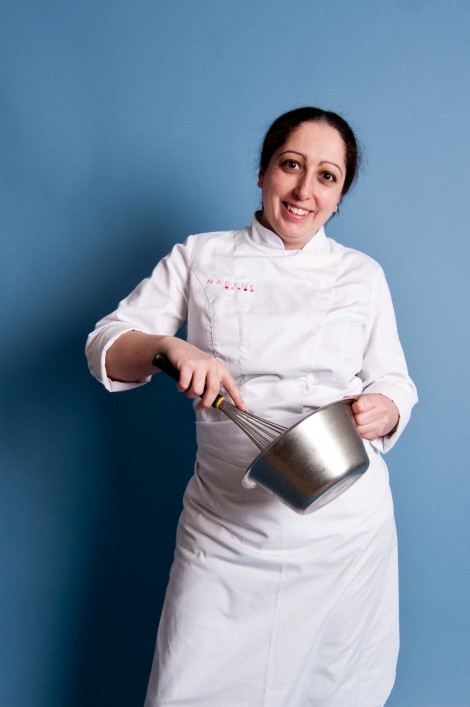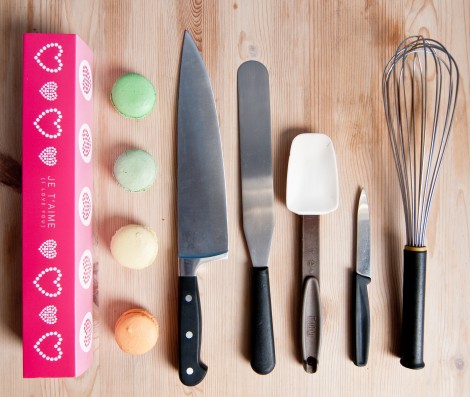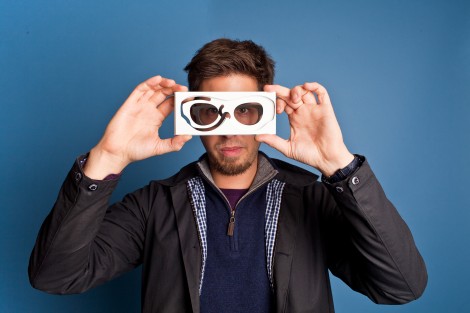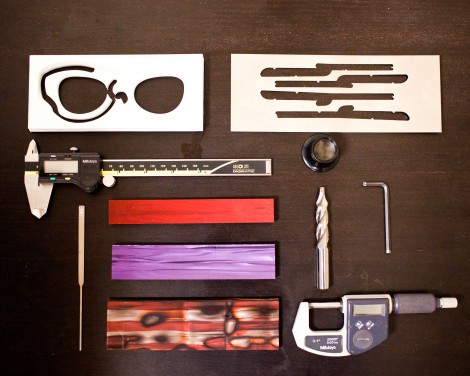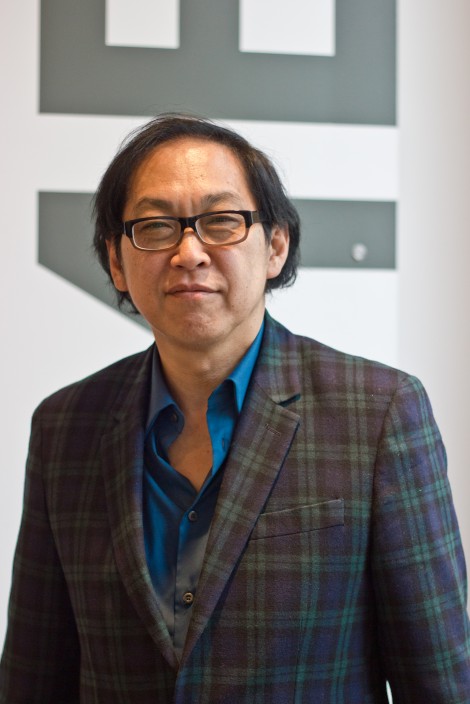NADÈGE NOURIAN
HEAD CHEF / FOUNDER
NADÈGE PATISSERIE
An elegant white room sits across from the south-east edge of Trinity Bellwoods Park, with full glass windows looking out on Queen Street West. The vividly coloured macaroons and cakes inside are the handiwork of Nadège Nourian and her partner Morgan McHugh, who opened Nadège Patisserie in 2009. French-born Nourian’s pastries proved to be a hit, and last year, the couple opened another patisserie in Rosedale.
What do you enjoy most about being a pastry chef?
NADÈGE NOURIAN
A few things, but I’ll say to make people happy… When you make cakes, it’s like the centerpiece of a wedding or a birthday. It’s kind of like the main piece of an important stage for people. Being a chef as well — the image of it, the kitchen — it’s a bit like the army sometimes. I like that! [laughs] I don’t know if that’s for everyone. Being part of a kitchen, being part of a team, is also like being part of a family.
THE VARSITY
How did you start working as a baker and chef?
NADÈGE NOURIAN
My parents had a little restaurant and I started working with them. I was 14, working in the kitchen and then in the front waitressing because I liked the connection with people as well. Then, I discovered pastry and decided to go more into pastry. Also, my family — my grandparents, great-grandparents, great-great-grandparents — had a pastry shop, so I’m actually the fourth generation.
THE VARSITY
When you’re coming up with a new design, where do you find inspiration?
NADÈGE NOURIAN
Every time is kind of different. Sometimes a lot will be from fashion. It all depends on how I attack the cake. Sometimes I really want to do this flavour, or I want that combination of flavours. Sometimes I really want to have that shape.
THE VARSITY
You mentioned fashion being an inspiration for you. Do you see other connections between what you do and other art forms?
NADÈGE NOURIAN
The way we work is the same. I’ll start with a computer or paper and pen, and I start to write ideas and I start to draw. What is there? What shapes? Then I will create a recipe or I’ll take some recipes and arrange them. Then, I go into the kitchen and I start to make it.
THE VARSITY
Is there a particular cake or dessert you’ve made that you’re most proud of?
NADÈGE NOURIAN
There’s one that we took off the menu, and people are asking me to put it back. It’s a very tricky cake with a lot of layers. It’s matcha green tea with raspberry and brown rice pudding.
THE VARSITY
Wow!
NADÈGE NOURIAN
There are so many layers, it’s crazy to make. The bottom layer is a matcha green tea sponge. Then after you have a matcha green tea ganache. Then you’ve got a brown rice pudding and then a raspberry mousse … and all around, we have a matcha green mousse. And then a chocolate spread!
THE VARSITY
Your store on Queen Street has a very nice, simple interior; what were you aiming for when you chose that interior?
NADÈGE NOURIAN
Well, a lot of people say “simple” — I don’t know. It is simple, but there are a lot of lines to the design. We went to a really nice company of architects [Nelson Kwong Architects]. Maybe because I’m French, I like modern things because I’m surrounded by old buildings all of the time. My pastries are very avant-gardiste and modern as well, so I did want something to reflect what I’m going to create and who I am. I love open concept… I wanted people to come into the store and see the food.
SHILO RAPP
HEAD DESIGNER
RAPP OPTICAL
Even if you’ve never heard of Rapp Optical, you’d probably recognize their frames. Rapp’s assemblages of thick, translucent plastic, brushed metal, and glass have been fixtures on the faces of Toronto’s most stylish since Mel Rapp started the company more than two decades ago. Today, Mel runs Rapp’s College Street storefront while his son, Shilo Rapp, crafts new designs at their North York factory.
THE VARSITY
How did you become a lens frame designer? Was there a moment when you decided that this was what you wanted to do?
SHILO RAPP
Not at all. I was born into it, my father being an optician for the last 30 years or longer. But I’ve worked in the shop all my life, so it kind of evolved gradually.
THE VARSITY
So you just kind of grew up around design and glasses?
SHILO RAPP
Well, the traditional school route that most people take wasn’t quite working for me, so I started working the shop. [My father] at the time had an interest in designing and manufacturing a line of pens, so that’s what kicked it off. There’s nowhere to go and learn how to make a pen anywhere; there’s no course you can take for it — or for eyewear, for that matter. It just set me down a whole route of different courses: goldsmithing, silversmithing, tool and die machining.
THE VARSITY
As an independent eyewear company, how hands-on is the process from initial designs to manufacture? Are glasses industrially manufactured, or is each pair really unique?
SHILO RAPP
Each pair of glasses is hand-finished entirely, so they get a lot of attention. We don’t use any mass finishing like the whole industry does. You’ll see most frames are round and glossy, and ours are really sharp and crisp, and the only way to achieve that is by hand. It’s hands-on for everyone who works at the factory.
THE VARSITY
Is eyewear manufacturing something that’s really determined by technological advances at this point?
SHILO RAPP
Glasses used to be made on manually driven pantograph milling machines. Now CAD/CAM technology [Computer Aided Design and Computer Aided Manufacturing] and CNC machinery [Computer Numerical Control Machinery] are the widely used ways to produce a frame. I think technology is changing everything, even how you design. You don’t even need to put a pencil to paper.
THE VARSITY
On a broader scale, I’d consider Rapp Optical a Toronto institution. Do you think Toronto is a good place for this sort of design?
SHILO RAPP
Absolutely — that’s my father and [stepmother] Julia’s doing. They are a wealth of knowledge in industry that I’m lucky to have access to. As far as the Rapp eyewear line goes … everybody’s responsible. I don’t even call myself a designer per se.
THE VARSITY
What do you call yourself?
SHILO RAPP
I don’t know, I’m starting to warm up to it just ‘cause it’s easier. But when people ask me what I do, I tell them I make things — because I love the process of manufacturing, how things are made. It’s just as exciting to me as the actual design of the object itself.
BRUCE KUWABARA
PARTNER
KPMB ARCHITECTS
The resumé of architect Bruce Kuwabara and his firm Kuwabara Payne McKenna Blumberg could easily double as a list of notable Canadian buildings. In Toronto, he has worked on the Gardiner Museum, the TIFF Bell Lightbox, the National Ballet School, and the ongoing expansion of the Rotman School of Management. Towards the end of 2011, Kuwabara was appointed a member of the Order of Canada. 
THE VARSITY
What do you enjoy most about being an architect?
BRUCE KUWABARA
Architecture is a fantastic experience because it is very much about creating the world we want to live in. In that one question, the question of what world do you want to live in, you have the opportunity to reflect on your own life, reflect on all of your aspirations and hopes for the future. Architecture in my mind is really a partner with the way we live; I think the more you do it, the more you realize how important that understanding is — that architecture isn’t just a kind of objectified building, but rather, a series of relationships between buildings and public space, notions of how to build and nurture communities within buildings, and how to make buildings that are truly sustainable and beautiful. So we always ask three questions: how does it work, does it work well, and how does it look and feel?
THE VARSITY
Do you think that good architecture can in turn create an environment that leads to creativity?
BRUCE KUWABARA
Oh, absolutely. That is the thesis. We’ve used different metaphors for architecture. One is that what you’re trying to create are the platforms upon which our clients — and some of them are cultural institutions or academic institutions — can really do their best work and really create a synergy within an institution and synergy that’s connected to the outside world. For example, we’re doing the Rotman School expansion; we made an event box room that sits up on the second floor that is a room for 400 first-year students. It’s a room that can accommodate the entire first-year class at the Rotman, but it’s also a space that projects its activity out to St. George Street.
THE VARSITY
You’ve been involved in architecture since the 1970s. How have both the materials you’re using and the processes changed since then?
BRUCE KUWABARA
The changes are incredible. We did a building for Manitoba Hydro, which is 700,000 square feet. It’s in Winnipeg; it’s in an extreme climate… They wanted to make a building that could achieve a reduction of 60 per cent of the National Model Energy code building. We designed some really beautiful systems.
THE VARSITY
What scope do you see for renovation in your buildings, or how do you accommodate for knowing that the buildings will age?
BRUCE KUWABARA
The structure of the building has to be modular and has to be robust. All the fixed elements like stairs and elevators and shafts have to be really well-placed. The way you get there is to make a proposal for all those elements and to try to lay out different scenarios of occupation… We’re doing that with the Kellogg School [at Northwestern University] now, where we’re making probably the most important decisions in the life of building… Flexibility has to be thought of deeply in terms of what it means. There’s nobody who would say, “I want an inflexible space,” but what is it? For me, flexibility is this: [Kuwabara stands up and slides a partition to reveal a meeting room]. We can use that room for some meetings. This is sort of like a Japanese house Is this room a conference room, a workroom, or a library? Does it matter? No. We get a lot of use out of it. We’ve had dinners here; we’ve had parties. That’s flexible.

